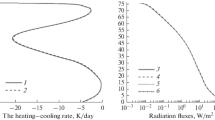Abstract
Rayleigh's original expression for the extinction coefficient is modified so that it can be used with respect to thestratified atmosphere composed of two or more gases mixed in a proportion that changes vertically. Using a model of the earth's molecular atmosphere based on the most recent rocket data available, some numerical values of this extinction coefficient are tabulated as a function of height, for three wavelengths (375, 520 and 835 mμ). By an integration of these values with respect to height, the normal optical thickness of the atmosphere is evaluated for different levels up to 30 km, and tabulated in sufficient detail to ensure a more accurate knowledge of this parameter than hitherto. The effect of seasonal changes in atmospheric density on the optical thickness is also determined. The expression for themass extinction coefficient derived on the above basis shows that it should be very nearly constant with respect to height in the stratified molecular atmosphere, and it is suggested that this might be used as an independent-check of upper atmospheric densities determined by other methods.
Zusammenfassung
Rayleighs ursprünglicher Ausdruck für den Extinktionskoeffizienten wird so abgeändert, daß er auch auf einegeschichtete Atmosphäre Anwendung finden kann, in der zwei oder mehr Gase in einem Verhältnis gemischt sind, das mit der Höhe variiert. Unter Benützung eines auf den neuesten Raketenaufstiegen beruhenden Modells für die Rayleigh-Atmosphäre werden Zahlenwerte des Extinktionskoeffizienten für drei verschiedene Wellenlängen (375, 520 und 835 mμ) als Funktion der Höhe mitgeteilt. Durch Integration dieser Werte über die Höhe wird die normale optische Schichtdicke der Atmosphäre für verschiedene Niveaus bis auf 30 km berechnet und der Einfluß der jahreszeitlichen Schwankungen der Dichte der Atmosphäre auf die optische Schichtdicke ebenfalls bestimmt. Es zeigt sich, daß der in dieser Weise berechnete Ausdruck für denMassenextinktionskoeffizienten hinsichtlich der Höhe in einer geschichteten, molekularen Atmosphäre nahezu konstant sein muß, und es wird vorgeschlagen, daß diese Tatsache zu einer unabhängigen Kontrolle der nach anderen Methoden bestimmten Luftdichten der hohen Atmosphäre benützt werden sollte.
Résumé
On modifie la formule primitive de Rayleigh experimant le coefficient d'extinction pour arriver à une forme applicable àl'atmosphère stratifiée et composée par deux ou plusieurs gaz dont la teneur a une variation verticale. On arrive à quelques valeurs quantitatives en utilisant un modèle de l'atmosphère moléculaire basé sur les données les plus récentes obtenues au moyen de fusées; ces valeurs sont présentées en fonction de la hauteur et pour trois longueurs d'onde (375, 520 et 835 mμ). Après une intégration par rapport à la hauteur on obtient l'épaisseur optique de l'atmosphère pour divers niveaux jusqu' à trente km; le détail numérique fournit une plus grande précision dans la connaissance de ce paramètre que jusqu' ici. On a aussi déterminé l'effet des variations saisonnières de la densité de l'atmosphère sur l'épaisseur optique. La formule pour lecoefficient d'extinction par unité de masse, obtenue par cette méthode, montre que ce coefficient doit être presque constant par rapport à la hauteur dans l'atmosphère moléculaire stratifiée et on propose la possibilité de l'utiliser comme contrôle indépendant des densités atmosphériques dans les hautes régions, déterminées par d'autres moyens.
Similar content being viewed by others
References
Strutt, J. W. (Lord Rayleigh):Phil. Mag.,41, 107, 274 (1871).
——,12, 81 (1881).
——,47, 375, (1899).
Deirmendjian, D.: Scientific Report 1, Contract AF 19 (122)-239, Air Force Cambridge Research Center, Cambridge, Mass. (1952).
Van de Hulst, H. C.: Chap. III in “The Atmospheres of the Earth and the Planets”, G. P. Kuiper ed., Univ. of Chicago Press, Chicago (1949).
Ayres, A. D.:Phys. Rev.,2, 161 (1913).
Partington, J. R.: An Advanced Treatise on Physical Chemistry,vol. 4, “Physico-Chemical Optics”. Longmans, Green & Co., London (1953).
Cabannes, J.: La diffusion moléculaire de la lumière. Presses Universitaires, Paris (1929).
de Vaucouleurs, G.:Ann. de Physique,6, 213 (1951).
Grimminger, G.: Analysis of the Temperature, Pressure and Density of the Atmosphere Extending to Extreme Altitudes. The Rand Corp., Santa Monica (1948).
Weekes, K.:Qu. J. Roy. Meteor. Soc. 80, 2 (1954).
Havens, R., R. Koll, andH. La Gow:Jour. Geoph. Res.,57, 59 (1952).
Kallmann, H. K.:Jour. Geoph. Res.,58, 209 (1953).
National Research Council, “International Critical Tables”, vol. 7, New York (1931).
DuMond, J. W. M. andE. R. Cohen:American Scientist,40, 447 (1952).
U. S. Weather Bureau, “Upper Air Average Values of Temperature, Pressure, ... etc”, Technical Paper No. 6, Washington, D. C. (1945).
Link, F. andZ. Sekera: Tables dioptriques de l'atmosphère terrestre, Publikace Pražské Hvězdárny, Prague (1941).
Penndorf, R.: In preparation for publication, privately communicated (1954). See alsoB. Goldberg,Jour. Opt. Soc. Am.,43, 1221 (1953).
Author information
Authors and Affiliations
Additional information
With 1 Figure.
U. C. L. A. Department of Meteorology, Research Paper No. 28. The research reported in this document has been sponsored in part by the Geophysics Research Directorate of the Air Force Cambridge Research Center, Air Research and Development Command, under Contract No. AF 19 (122)-239.
Rights and permissions
About this article
Cite this article
Deirmendjian, D. The optical thickness of the molecular atmosphere. Arch. Met. Geoph. Biokl. B. 6, 452–461 (1955). https://doi.org/10.1007/BF02242749
Issue Date:
DOI: https://doi.org/10.1007/BF02242749



